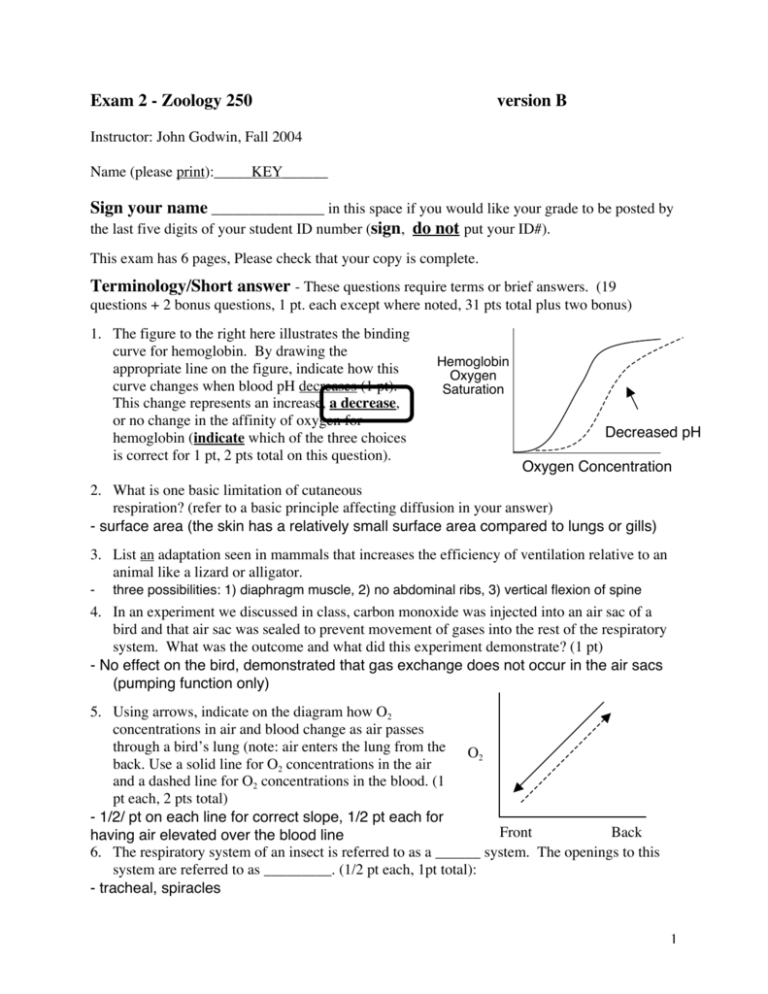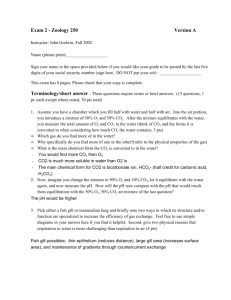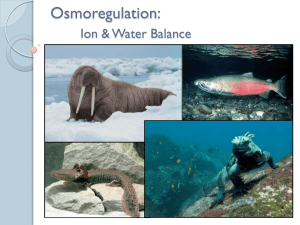Exam 2 - Zoology 250 version B
advertisement

Exam 2 - Zoology 250 version B Instructor: John Godwin, Fall 2004 Name (please print):_____KEY______ Sign your name _______________ in this space if you would like your grade to be posted by the last five digits of your student ID number (sign, do not put your ID#). This exam has 6 pages, Please check that your copy is complete. Terminology/Short answer - These questions require terms or brief answers. (19 questions + 2 bonus questions, 1 pt. each except where noted, 31 pts total plus two bonus) 1. The figure to the right here illustrates the binding curve for hemoglobin. By drawing the appropriate line on the figure, indicate how this curve changes when blood pH decreases (1 pt). This change represents an increase, a decrease, or no change in the affinity of oxygen for hemoglobin (indicate which of the three choices is correct for 1 pt, 2 pts total on this question). Hemoglobin Oxygen Saturation Decreased pH Oxygen Concentration 2. What is one basic limitation of cutaneous respiration? (refer to a basic principle affecting diffusion in your answer) - surface area (the skin has a relatively small surface area compared to lungs or gills) 3. List an adaptation seen in mammals that increases the efficiency of ventilation relative to an animal like a lizard or alligator. - three possibilities: 1) diaphragm muscle, 2) no abdominal ribs, 3) vertical flexion of spine 4. In an experiment we discussed in class, carbon monoxide was injected into an air sac of a bird and that air sac was sealed to prevent movement of gases into the rest of the respiratory system. What was the outcome and what did this experiment demonstrate? (1 pt) - No effect on the bird, demonstrated that gas exchange does not occur in the air sacs (pumping function only) 5. Using arrows, indicate on the diagram how O2 concentrations in air and blood change as air passes through a bird’s lung (note: air enters the lung from the O 2 back. Use a solid line for O2 concentrations in the air and a dashed line for O2 concentrations in the blood. (1 pt each, 2 pts total) - 1/2/ pt on each line for correct slope, 1/2 pt each for Front Back having air elevated over the blood line 6. The respiratory system of an insect is referred to as a ______ system. The openings to this system are referred to as _________. (1/2 pt each, 1pt total): - tracheal, spiracles 1 7. A protein in human blood named Transferrin tightly binds iron and only releases it to cells with specific transferrin receptors. Defects in this system increase susceptibility to infection. Based on our discussion in class, why should this be? (2 pts) - Iron withholding helps fight infections, increases in iron concentrations with transferring defects make iron available to pathogens 8. B cells are responsible for antibody- mediated immunity while T cells are responsible for cell-mediated immunity. (1/2 pt each). 9. By what mechanism might fever work as a defense against pathogens? - Increases body temperature to higher than is optimal/good for pathogen 10. List three types of General Defenses against pathogens (as opposed to defenses against specific species of pathogens; 1 pt each for 3 pts total). Several possibilities here: Barriers (e.g., skin, mucous membranes), inhibitors (e.g., lysozyme, magainins), grooming behavior, pain, movement of mucus from respiratory tract, coughing, vomiting, diarrhea, saliva, tears, low pH of stomach and skin, ecological competition with normal flora, various non-specific cellular defenses (neutrophils, monocytes, macrophages, eosinophils, natural killer cells), inflammation, fever, iron withholding 11. What specific cell type also often referred to as a ‘CD4 lymphocyte’ is critical for stimulating other components of the immune response, and exhibits greatly reduced numbers in later stages of AIDS? – Helper T cells 12. What specific class of antibodies is critical for allergic responses to things like pollen? - IgE antibodies 13. What two features of the HIV virus and HIV infection make it so difficult for both the immune system and clinicians to prevent progression to AIDS? (1 pt each, 2 pts total) - HIV uses this receptor to enter immune system cells (along with the CD4 protein – not necessary for credit) 14. What is the importance of the chemokine receptor CCR5 in the process of HIV infection? - 1) Mutates/Changes rapidly (i.e., a ‘moving target for immune system) - 2) the virus attacks the immune system itself 15. What are the basic problems faced by a freshwater fish in regulating a) ions and b) water in its body fluids? List one ‘solution’ (physiological or morphological adaptation) that helps these fish deal with one or both of these problems. (1 pt each, 3 pts total) a) Ions – FW fish lose ions, b) Water – FW fish gain water. c) Solutions – Several are possible: i) much of body surface is impermeable, ii) don’t drink water, iii) transport ions in at gills, iv) don’t drink water, v) produce copious, dilute urine (either or both of these is fine here) 2 16. What is the basic functional unit of the vertebrate kidney? What more specific type of this basic functional unit type is important in giving mammals the ability to generate concentrated urine? (1 pt each, 2 pts total) - Basic functional unit: nephron, specific type: juxtamedullary nephrons 17. Indicate how a) an osmoconformer and b) an osmoregulator would react to a change in the osmotic concentration of their environment by drawing the appropriate lines on the axes to the right here (1 pt each, 2 pts total). Osmoregulator (should be flat) Osmotic concentration of Body fluids Osmoconformer (changes with environment) Osmotic Concentration of the Environment 18. What are the main excretory structures of insects termed? Malpighian tubules 19. What is the state where a small endotherm lets its body temperature drop for short periods termed? Briefly, why might an animal like a hummingbird do this at night? (1 pt each, 2 pts) - Torpor; This saves energy (often when it is difficult to feed) Bonus: What ‘manipulation’ performed at Mauke Atoll unintentionally shed light on the possible function of the reaction seen with allergies? (1 pt) - treatment for worm infections (disappearance of infection was followed by the appearance of allergies) Bonus: Briefly, why is it functionally important that hemoglobin shows cooperative binding of oxygen? (1 pt) - This produces the ‘S-shaped’ binding curve that promotes rapid on- and off-loading of oxygen over a relatively small range of oxygen concentrations Multiple Choice (1 pt each, 23 points total ) 1. I am writing version ___ of this exam. a) A b) B 2. The total maximum volume of air that can be moved in and out of the human lungs in a single ‘breath’ is referred to as the: a) Residual volume b) Vital capacity c) Tidal volume d) Alveolar volume e) Balloon volume 3 3. The parabronchial lung is characteristic of: a) Mammals b) Birds c) Insects d) Terrestrial fishes e) Spiders 4. Frogs exhibit _______ ventilation a) Positive pressure b) Negative pressure c) Anaerobic 5. Increases in CO2 dissolved into the blood have what effect on blood pH? a) Increased pH b) Decreased pH c) No effect 6. How does the solubility of CO2 and O2 in water compare? a) The solubility of CO2 and O2 in water are equivalent b) CO2 is less soluble than O2 c) CO2 is more soluble than O2 d) Neither CO2 or O2 dissolves in water to any signficant extent 7. Which of the following is NOT a reason the type of respiratory system found in insects would not work for a crustacean that is aquatic. a) Water is dense b) Water holds relatively little O2 c) Diffusion is slow in water relative to air d) O2 is very soluble in water 8. Most CO2 actually travels in blood in what form? a) CO2 b) O2 c) HCO3d) H+ e) H20 9. The respiratory pigment used by vertebrates is hemoglobin. The respiratory pigment found in invertebrates such as crabs is termed: a) Hemocyanin b) Hemophilin c) Lactoferrin d) Thrombin e) Perforin 10. Respiratory turbinates function to: a) Conserve heat and moisture during respiration b) Reduce excess heat and moisture during respiration c) Ventilate the lungs during respiration d) Increase the surface area available for gas exchange 4 11. Diving mammals store a considerable amount of oxygen in their muscles during dives by having high levels of which protein? a) Hemoglobin b) Hemocyanin c) Myoglobin d) Myostatin e) Immunoglobulin 12. The macrophages important in the inflammation response are already macrophages when they enter the tissue. a) This statement is true b) This statement is false 13. B cells mature in the _______. a) Thymus gland b) Thyroid gland c) Lymph nodes d) Lacteals e) Bone marrow 14. In the inflammation response, ______ and ________ are released shortly following an injury. a) Histamines b) Prostaglandins c) Progestins d) A and B are correct e) A and C are correct 15. Which of the following best describes ‘clonal selection’ in immune responses? a) Immune cells adapt the type of antibody they produce to the pathogen they are exposed to b) Immune cells have the type of antibody they produce determined before maturation c) Immune cells contact other immune cells that have encountered a pathogen and change the type of antibody they produce to match the type made by that cell. 16. The more rapid response of the immune system to a specific antigen on the second exposure is an example of which immune system key feature: a) Specificity b) Diversity c) Memory d) Self/non-self recognition e) None of the above 17. Which of the choices below reflects the right order for the relative toxicity of the major nitrogenous wastes in vertebrate animals? a) uric acid > urea > ammonia b) uric acid > ammonia > urea c) ammonia > uric acid > urea d) ammonia > urea > uric acid e) urea > ammonia > uric acid 5 18. What is the main type of nitrogenous waste used by birds? a) Urea b) Ammonia c) Uric acid d) Nitrate e) Nitrous oxide 19. While many marine animals do not regulate the osmotic concentration of their body fluids to be different from that of seawater, marine animals do maintain ion concentrations in body tissues that are different than those of seawater. a) This statement is true b) This statement is false 20. A population of the bull shark, a marine animal, long ago established itself in Lake Nicaragua. To adapt to the change in their osmotic environment, these sharks show altered levels of a compound that marine sharks use to adapt to the seawater environment. Based on what you know about osmoregulation in seawater by sharks, what change would you predict in these freshwater sharks relative to their marine ancestors? a) Increased ammonia levels b) Decreased ammonia levels c) Increased urea levels d) Decreased urea levels e) Decreased uric acid levels 21. Vampire bats can produce a urine that is approximately 14 times as concentrated as their blood. How much water is lost excreting nitrogenous wastes in a vampire bat relative to what would be lost if the animal could not generate a concentrated urine? a) ~25% as much b) ~7% as much c) ~200% as much d) ~1400% as much e) about the same amount 22. Which of the following is a adaptation for thermoregulation typically found in endotherms, but not ectotherms? a) Insulation b) Blood shunts c) Vasodilation d) Behaviors that affect exposure to sources of heat or cold 23. Bonus Multiple Choice question: The protein that identifies the body’s cells as different from pathogens to cells of the immune system is: a) MHC I b) MHC II c) Perforin d) CD8 6








